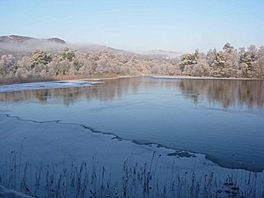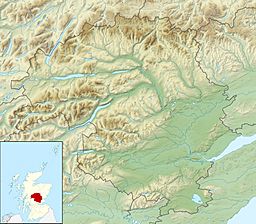Loch of the Lowes facts for kids
Quick facts for kids Loch of the Lowes |
|
|---|---|

December 2005
|
|
| Location | NO049438 |
| Coordinates | 56°34′38″N 3°32′56″W / 56.5773°N 3.5489°W |
| Type | freshwater loch |
| Primary inflows | Lunan Burn |
| Primary outflows | Lunan Burn |
| Catchment area | 14.9 km2 (3,680 acres) |
| Basin countries | Scotland |
| Max. length | 310 m (1,020 ft) |
| Max. width | 201 m (659 ft) |
| Surface area | 87.9 ha (217 acres) |
| Average depth | 4.9 m (16 ft) |
| Max. depth | 16 m (53 ft) |
| Water volume | 5,492,700 m3 (193,973,000 cu ft) |
| Shore length1 | 4.4 km (2.7 mi) |
| Surface elevation | 101 m (331 ft) |
| Max. temperature | 15.6 °C (60.0 °F) |
| Min. temperature | 10.0 °C (50.0 °F) |
| Islands | 0 |
| 1 Shore length is not a well-defined measure. | |
Loch of the Lowes is a beautiful loch (a Scottish word for lake) located near Dunkeld in Perth and Kinross, Scotland. It's a very special place for nature lovers!
The loch and the land around it are a protected wildlife reserve. This reserve is managed by the Scottish Wildlife Trust, an organization that works to protect Scotland's natural places. Loch of the Lowes is also known as a Site of Special Scientific Interest (SSSI) and a Special Area of Conservation. These titles mean it's a really important spot for wildlife and habitats.
You can find all sorts of amazing animals here, including a pair of ospreys that nest and raise their young, red squirrels, otters, and even beavers. In early winter, many greylag geese come to the loch to rest during their migration. You might also spot goldeneyes, mallards, goosanders, wigeons, teals, tufted ducks, and great crested grebes.
Contents
History of the Loch
In the 1800s, a special ditch called a drainage canal was dug. This canal connected Loch of the Lowes with another loch called Loch of Craiglush. This made the water levels in both lochs the same. Today, the Lunan Burn flows through this canal.
The Scottish Wildlife Trust bought the land for the reserve in 1969. They did this because Loch of the Lowes is the biggest "mesotrophic" loch in the area. This means it has a medium level of nutrients, which is important for certain plants and animals. A rare plant called Slender Naiad also grows here, making the loch even more special.
Geography of the Lunan Lochs
Loch of the Lowes is part of a group of lochs known as the Lunan Lochs. This chain of lochs includes Craiglush, Lowes, Butterstone, Clunie, and Marlee.
All these lochs are connected by the Lunan Burn. This burn eventually flows into the River Isla, which then joins the larger River Tay.
Loch of the Lowes, along with Loch Craiglush and Loch Butterstone, are located just north of the Highland Boundary Fault. This is a major geological line in Scotland. These lochs are "mesotrophic," meaning they have a moderate amount of nutrients. This is because the land around them is mostly acidic uplands. In contrast, Lochs Clunie and Marlee are south of this fault and have more nutrients. The Lunan Lochs are a rare example in the UK of a habitat where lochs change from having few nutrients upstream to more nutrients downstream.
Amazing Wildlife
The loch and the woodlands around it are home to many different kinds of animals.
Birds of the Loch
The loch is a fantastic place for birdwatching!
- In winter, you can see pink-footed geese, greylag geese, wigeons, and whooper swans on the water.
- In summer, many swallows, sand martins, and swifts fly over the loch, catching insects.
- Some birds, like tufted ducks, goldeneyes, and great crested grebes, can be seen all year round. In early spring, you might even see the goldeneyes and great crested grebes doing their special courtship dances!
In the nearby woodlands, you can spot birds like jays, treecreepers, great spotted woodpeckers, siskins, and sparrowhawks. When winter comes, redpolls and bramblings visit the woods. In summer, look out for redstarts and cuckoos.
Osprey Nesting and Reproduction
From late March to late August, a pair of ospreys makes their home here. They build their nest very close to an observation hide, which is like a hidden viewing spot. This allows visitors to get a fantastic view of the ospreys through binoculars or telescopes. You can even watch them on a closed-circuit television (CCTV) screen at the Visitor Centre or online through a special HD camera!
Mammals You Might See
You might be lucky enough to see fallow and roe deer from the hide. Sometimes, otters can be seen playing in the water. Red squirrels are also very common in the reserve. Recently, a beaver has made the loch its home. This beaver is thought to be related to other beavers in the Tay area, likely from beavers that escaped from captivity.
Fish in the Loch
The loch is home to pike, perch, and brown trout. However, fishing in or on the loch is not allowed at any time of the year. This helps protect the fish and the loch's ecosystem.
How to Visit
Loch of the Lowes is about 2 miles (3 km) north-east of Dunkeld. You can get there by taking a small road off the A923 which leads to a car park at the reserve.
There's a footpath that connects the loch to Dunkeld. It's great for walkers and cyclists, but it's not suitable for wheelchairs. The reserve car park has a cycle rack and space for about 24 cars.
Visitor Centre and Hides
The Scottish Wildlife Trust has a visitor centre on the western side of the loch. This centre is a great place to learn more about the wildlife. There are also three observation hides that give you amazing views over the loch, especially near the osprey nest.
The Loch of the Lowes Visitor Centre is one of four visitor centres run by the Scottish Wildlife Trust. The others are at Montrose Basin, Falls of Clyde, and Jupiter Wildlife Centre.
Opening Hours
- 1 March to 31 October: Open every day from 10:00 AM to 5:00 PM.
- 1 November to 28 February: Open Friday to Sunday from 10:30 AM to 4:00 PM.



